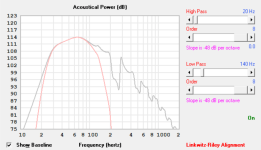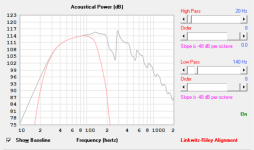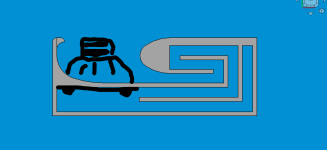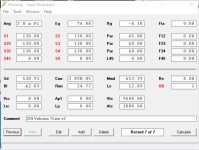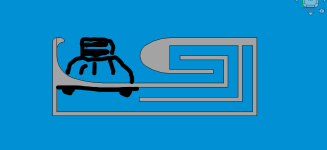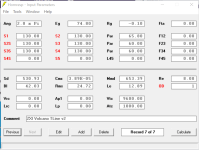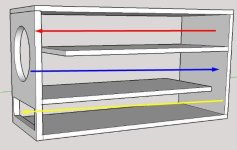As I noted here, the specs 'in toto' are just a bunch of 'floobie dust' with the intent of elaborating, but you kept me busy to the point I forgot to do it, but the thing is there's real specs (BL, CMS, etc.), and and then there's T/S specs (Qt, Vas, etc.), derived from them and the two sets are wildly different, hence used the 'best' of the two and made my later remarks based on the worst one and the wide gap between them.GM
I noticed that our driver data is very different. Which numbers did you use? They look nothing like the manual
In short, if they don't at least match very close, then it's a 'caveat emptor' scenario where historically one needs to either measure them or build the biggest box tolerated and fine tune to 'taste' and it 'is what it is'.
I expected to see a much different response from a driver with proper specs and no multi voice coil related ambiguities
Anyway, not too comfortable with the idea of such a large wattage driver in a sealed 20L volume. The retail packaging box is 36.2L!!! I intend to reverse the driver in all the designs using a very small box to avoid enclosed volumes of air holding heat
I do have a plan for forced induction cooling of the magnets and motor structure using a machined alloy system but for the very basic Volcano box types, just avoiding that whole mess by reversing the driver will suffice
I am making the assumption that for sealed, box shape doesn't matter too much as long as a linearish cushion of air is seen by the driver. With the driver being reversed, I imagine exploiting basket shape as a design basis. This might look ok in a domestic or car situation. Or a pro situation that calls for a sealed sub. Being a sealed volume, it can accommodate any driver that can fit the baffle area. The volume is very scalable. The WinISD response for sealed is not too shabby and might just serve for some initial real use
I do intend to run a Pass H2 on the sub front end to give the sound some colour, and maybe also try interfering with the DSP to colour it further
Let's build this box and break in the driver in the car while waiting for the refurbished laptop to arrive, and then run some tests as a way forward. As I mentioned, a sealed box is a sealed box and not tied to a driver. What I imagine is quite different, and hopefully the effort would be of use to others
The volcano theme has really gelled with me due to the driver shape, component colours and what shapes I can create with it, so time to make the Volcano TLS (Transmission line, sealed). 20L native, scalable +/-, suit any driver size. Hope to give back to the forum from long background in crafting and engineering shapes as well as creating workflows for easy DIY of advanced shapes that natively suit easy reproducing of more units
Anyway, not too comfortable with the idea of such a large wattage driver in a sealed 20L volume. The retail packaging box is 36.2L!!! I intend to reverse the driver in all the designs using a very small box to avoid enclosed volumes of air holding heat
I do have a plan for forced induction cooling of the magnets and motor structure using a machined alloy system but for the very basic Volcano box types, just avoiding that whole mess by reversing the driver will suffice
I am making the assumption that for sealed, box shape doesn't matter too much as long as a linearish cushion of air is seen by the driver. With the driver being reversed, I imagine exploiting basket shape as a design basis. This might look ok in a domestic or car situation. Or a pro situation that calls for a sealed sub. Being a sealed volume, it can accommodate any driver that can fit the baffle area. The volume is very scalable. The WinISD response for sealed is not too shabby and might just serve for some initial real use
I do intend to run a Pass H2 on the sub front end to give the sound some colour, and maybe also try interfering with the DSP to colour it further
Let's build this box and break in the driver in the car while waiting for the refurbished laptop to arrive, and then run some tests as a way forward. As I mentioned, a sealed box is a sealed box and not tied to a driver. What I imagine is quite different, and hopefully the effort would be of use to others
The volcano theme has really gelled with me due to the driver shape, component colours and what shapes I can create with it, so time to make the Volcano TLS (Transmission line, sealed). 20L native, scalable +/-, suit any driver size. Hope to give back to the forum from long background in crafting and engineering shapes as well as creating workflows for easy DIY of advanced shapes that natively suit easy reproducing of more units
Will be good for this in a few days. Placed an order for the following just now. Hope this serves well as a DJ/bench PCbut you've yet to measure some broken in driver specs
DynaBook Portege X30W-J
Most of all, I hope this ends my FreeCAD crashes. Yours truly has been getting FreeCAD to crash over the past day with SEALED boxes!!!!!
I hope this thing will run REW/ARTA well
Maybe you’re simulating extremely small qw pipes and very overdamped frequency responses don’t really show much detail except the higher ‘Le’ and moving mass of the strange ‘ds18’ driver creating the high frequency roll off shape ?
Did you notice that the 3 part TL segments can be laid down as one pipe and would look like the surfboard you once asked to model?Maybe you’re simulating extremely small qw pipes and very overdamped frequency responses don’t really show much detail
How do we bring a driver with a 16L Vas and a TL together? Curious to hear what a 12" driver sounds like when bolted onto a TL meant for 6" drivers
We can't rely on the driver data. Even DS18 seem to be aware of this and have stated that they are in the process of remeasuring the drivers for broken in specs, which implies that the current specs may be invalid and from drivers that may not have been broken inthe higher ‘Le’ and moving mass of the strange ‘ds18’ driver creating the high frequency roll off shape ?
I have quite a few different DS18 subs, FR and 2-way drivers here and the fit and finish is impeccable. Makes Dayton's appear to be assembled by kindergarteners. The ZXI12.4D appears to be better built than the W7, too. DS18 seem to have a great quantity of driver choices in each frame size and all aimed at different lil niches. The problem seems to be a data entry one to me. The way WinISD auto calculates shows that something is botched in the dual voice coil config. Feels consistent with WinISD sort of showing that the measured specs are of one coil but derived are for series connection. Correcting for that actually shows gorgeous response, but not knowing exactly what's going on makes that unreliable as well
Measuring the driver once the new Tablet PC arrives will be interesting
GadgetGuy’s take:
The Dynabook Portégé X30W-J is wonderfully light, powerful and pretty perfect.
As the evolution (Evo) from 2020 Athena notebooks (that we also considered pretty perfect), it has everything you could want. Plus, something uniquely Dynabook – no marketing hype.
We have never seen a more subdued website, no outrageous claims, a full set of specifications, and plain good information- ten points to Dynabook.
There are many 11th Gen Intel Core Portégé models, too, so you can get what you want. The PDA11A-01N003 (as tested) i5 with 16GB of RAM at $2299 is perfect for most users. The top specified i7/16/512GB is $2574. But remember, you will only see these at approved, specialist resellers – these are not CE retail products.
Rating this is easy – it is a clear 10/10. But it is the first Evo format we have reviewed, and we may revisit that score after we see HP, Lenovo, Dell, ASUS efforts.
Note on review ratings
The original review of 5 January 2021 was an early production sample. Dynabook sent a production model in late August to ‘revisit’. We stand by our perfect score review
It's good when things are specced well. Happy with the laptop choice. It appears to have been the performance leader three years ago, and I paid AUD $309 shipped for a refurbished unit and with a year's warranty. This seems to be a good contender to upping the RAM to max. The system has the power to make good use of it. It benchmarks as 75x better than my current i5 6500 desktop. Power to run 4x monitors is going to be very handy as I am going to set up a large 46" screen + a 3x 10" monitor array built around DIY screens from ALi
The seller has more of these, so there is a bargain to be had for Aussies. Just search eBay for model name
https://www.ebay.com.au/itm/1562432...-acd7-dae82f6fc5e7|iid:1|vlpname:vlp_homepage
'Piece o' cake' 😉 Calculate a max flat alignment (cm^3), then find its square area (cm^2) = pipe area (i.d.), now make it as long as the desired tuning is required.How do we bring a driver with a 16L Vas and a TL together? Curious to hear what a 12" driver sounds like when bolted onto a TL meant for 6" drivers
The way I did it before T/S was to convert factory box designs to whatever size vent area was required to make the driver fit and long enough to 'hit' the desired tuning (historically Fs).
Dream setup. The Gen-11 CPU can do 4x displays and this hub can support that
https://www.aliexpress.com/item/100...=scene:pcDetailTopMoreOtherSeller|query_from:

https://www.aliexpress.com/item/100...=scene:pcDetailTopMoreOtherSeller|query_from:
How do you make an appropriate qw pipe and exit size/vent speed with a 12” driver with such a tight VAS?
So ignore the TS parameters and just create a tuned qw tube that’s 2 x Sd at the closed end and 0.5 x Sd at the vent end .
(2 x Sd is nearly the ‘perfect’ squaring of the circle shape needed to fit the driver or provides the depth for the motor to fit if tapped in sideway? that taper ratio prevents a longer length of a ‘straight TL with no taper where the harmonics get into the ‘subwoofer’ bandwidth)
It seems to me that is the ‘smallest’ tapered qw tube we can create that doesn’t get noisy at the exit or present a bunch of resonances @ 3x Fb ?
the other option (even smaller for the same Fb) would be to just fold the 2 x Sd section (chamber) into the 0.5 Sd section(port) with no gradual ‘taper‘ shape?
i sometimes wonder if the tapered shape isn’t less noisy or full of pipe and port resonances ? it sounds ‘better’ to me when driven hard but I’ve only done a dozen of these or so in various forms/shapes with the same drivers or similar to try and ‘study’ ?
the other option (even smaller for the same Fb) would be to just fold the 2 x Sd section (chamber) into the 0.5 Sd section(port) with no gradual ‘taper‘ shape?
i sometimes wonder if the tapered shape isn’t less noisy or full of pipe and port resonances ? it sounds ‘better’ to me when driven hard but I’ve only done a dozen of these or so in various forms/shapes with the same drivers or similar to try and ‘study’ ?
Last edited:
The diagram could be modeled as a TH.
The diagram and Hornresp inputs are very different.
The ZX1 VolcanoTLine v2 is useless, whatever you call it 😢Models as a line, but I still see a tapered driver operating chamber and a straight port with an exit flare. What is it?
That is not the correct system model, Drawn is a 1/3rd offset but your model shows 2/3. Even the TH 1 model works iwhen you add the exit flare as mouth too
The Schematic Diagram I posted in #76 is from the "ZX1 VolcanoTLine v2" Hornresp inputs you posted in #75.That is not the correct system model, Drawn is a 1/3rd offset but your model shows 2/3.
Art has the driver at 120 cm instead of 60 cm by using ‘OD1’ instead of ‘OD’. (Easy mistake to make in horn response weve all likely done). You’re not really drawing either scenario, legitamitely, so it doesn’t matter ..(??)
its putting a big cancelation notch at ~72 hz (120cm) as a result. (Instead of removing a 60 cm/144hz resonance and cancelation notch thereafter (tapped pipe)
Nevertheless, Why would you put a 12” sub in a 130 cm2 tube that long and twisty? Vent speed and noise and ??? No bass.
its putting a big cancelation notch at ~72 hz (120cm) as a result. (Instead of removing a 60 cm/144hz resonance and cancelation notch thereafter (tapped pipe)
Nevertheless, Why would you put a 12” sub in a 130 cm2 tube that long and twisty? Vent speed and noise and ??? No bass.
Attachments
Last edited:
Oops, my mistake.Art has the driver at 120 cm instead of 60 cm by using ‘OD1’ instead of ‘OD’. (Easy mistake to make in horn response weve all likely done). You’re not really drawing either scenario, legitamitely, so it doesn’t matter ..(??)
Response looks better as OD instead of OD1, but it's schematic looks even less like the scoopy diagram in #75 which has the driver located by the horn exit.
- Home
- Loudspeakers
- Subwoofers
- Flared BR ports with Hornresp?
